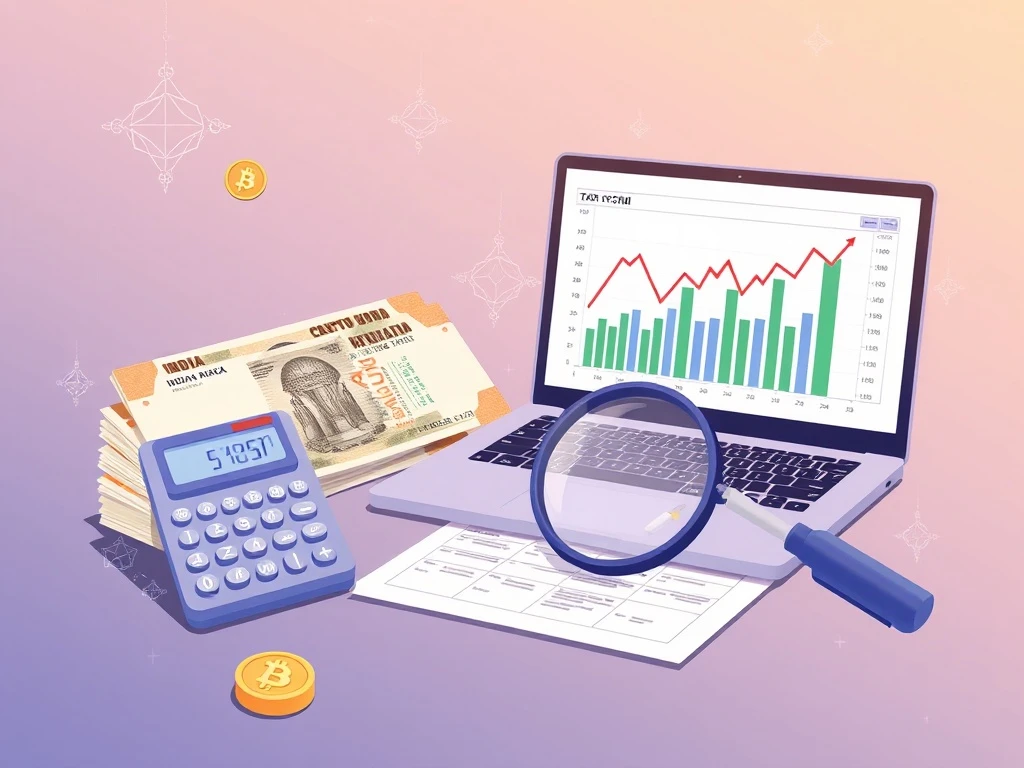Crypto Taxes India: Crucial Guide for Traders in 2025 Explained

Understanding **crypto taxes India** is now more critical than ever for traders. India’s digital asset landscape is rapidly evolving. Therefore, staying compliant with tax laws remains paramount. This comprehensive guide helps traders navigate the complex **India crypto tax** framework for 2025. We will break down essential regulations and requirements. Furthermore, we provide clear insights to help you manage your virtual digital assets (VDAs) effectively. Many investors find these rules challenging. However, informed decisions can prevent future complications. This article aims to clarify the often-confusing tax landscape for cryptocurrencies in India.
Understanding India’s Crypto Regulatory Framework
For the financial year 2024-2025, Indian tax law officially treats cryptocurrencies as Virtual Digital Assets (VDAs). This classification falls under the Income Tax Act, 1961. Specifically, Section 2(47A) defines VDAs broadly. Any code, number, token, or piece of information created through cryptography qualifies as a VDA. However, money itself, including Indian rupees or any other country’s fiat currency, remains an exception. This means popular cryptocurrencies like Bitcoin (BTC) and Ether (ETH) are VDAs. Non-fungible tokens (NFTs) and similar digital tokens also fall under this definition. While buying, selling, and holding VDAs is legal, they are not recognized as valid payment methods. Consequently, crypto operates in a legally ambiguous space in India. It is permitted but closely monitored. This monitoring focuses on taxation and anti-money laundering (AML) purposes. The government seeks to balance innovation with financial stability. Therefore, understanding these nuances is vital for every trader.
Key Regulatory Bodies and the 2025 Tax Bill
Several agencies in India oversee crypto transactions. The Income Tax Department enforces tax compliance. It follows guidelines set by the Central Board of Direct Taxes (CBDT). The Ministry of Finance governs the CBDT. They together establish tax policies for VDAs. Meanwhile, the Financial Intelligence Unit (FIU-IND) ensures platforms meet AML standards. The Reserve Bank of India (RBI) and the Securities and Exchange Board of India (SEBI) shape broader regulatory policies. These bodies collaborate to oversee **crypto regulations India**. They aim for a structured approach to digital assets. A significant development occurred with the Income Tax (No. 2) Bill, 2025. This bill received presidential assent on August 22, 2025. It officially replaced the Income Tax Act, 1961. This new legislation further solidified the framework for **VDA tax India**. Traders must understand these changes. They directly impact their tax obligations and reporting.
Identifying Taxable Events for Crypto Traders
India places crypto transactions under a specific tax framework. This includes a flat 30% tax on gains from transfers. Moreover, a 1% Tax Deducted at Source (TDS) applies to all transfers. This TDS applies whether the transaction is profitable or not. A taxable event in crypto is any activity that creates a tax liability. This happens under Indian law. It includes transactions that produce income, gains, or measurable benefits in fiat money. If you trade or invest, knowing what counts as a taxable event is key. It ensures compliance with the Income Tax Act. Therefore, careful tracking of all activities is essential. Here are the key taxable events:
- Trading: Exchanging crypto for another crypto or fiat currency is taxable. Each such transaction generates a tax liability.
- Staking Rewards: These are counted as income when received. The value is determined at the time of receipt.
- Airdrops and Hard Forks: Tokens received from airdrops or hard forks are treated as income. This occurs once tokens are credited to your wallet.
- Mining Income: Income from mining activities is taxed as business income. Subsequent sales of mined crypto are subject to capital gains tax.
- Payments in Crypto: Using crypto for payments is considered a sale. This triggers taxable business or professional income for the recipient.
Non-taxable events include holding digital assets without selling or transferring crypto between your personal wallets. These actions do not produce income or gains. Consequently, they are not subject to tax. Traders should carefully distinguish between these activities. Did you know? Indian law offers no tax relief if you lose your crypto due to theft or hacks. Non-compliance can attract penalties, interest, and prosecution for willful evasion. This highlights the strict nature of **India crypto tax** rules.
Crypto Tax Rates and Classifications in India
In India, income from cryptocurrencies primarily falls into two categories. These are business income or capital gains. If trading is regular and systematic, earnings are taxed as business income. This happens under standard income tax slabs. For most individual investors, however, profits from buying and selling cryptocurrencies are considered capital gains. As of August 22, 2025, both short-term capital gains (STCG) and long-term capital gains (LTCG) on VDAs are taxed at a flat 30% rate. This rule operates under Section 115BBH of the Income Tax Act. This flat rate applies regardless of how long the assets are held. Furthermore, no deductions, except the cost of acquisition, are permitted. Losses from one VDA cannot be offset against another. They also cannot be carried forward to future financial years. This strict provision makes managing losses particularly challenging for traders. Business income from crypto is taxed at slab rates. However, it often faces a similar tax burden due to the flat 30% rate for VDAs. Additionally, a 1% TDS is applied to all crypto transfers above a certain threshold. This ensures transparency and compliance across various platforms. This includes trades on centralized exchanges and peer-to-peer (P2P) transactions. Understanding these classifications is vital for accurate **VDA tax India** reporting.
Navigating TDS on VDAs in India: Section 194S Explained
India’s tax framework for cryptocurrencies includes a mandatory 1% TDS. This deduction falls under Section 194S. It applies to most VDA transactions. The government introduced this measure to improve compliance. It also helps monitor the expanding crypto market. This mechanism aims to track transactions more effectively. The main aspects of **TDS crypto India** are as follows:
- TDS Mechanism: When purchasing a VDA, the buyer deducts a fixed percentage of the sale amount as TDS. They then deposit this amount with the government. This deducted amount represents the tax withheld from the seller’s payment.
- TDS Rate and Threshold: Section 194S imposes a 1% TDS on the sale amount. This applies if transactions exceed 50,000 Indian rupees in a financial year. In certain cases, this threshold is lowered to 10,000 rupees. This lower threshold applies to specific categories of buyers.
- TDS for Non-Cash Transactions: If a buyer purchases a VDA using another VDA (a non-cash payment), they must deduct 1% TDS in cash. This deduction is based on the sale value. The buyer must then submit it to the government.
- Mixed Payment Scenarios: When a buyer pays for a VDA with a combination of cash and non-cash (e.g., another VDA), and the cash portion is insufficient to cover the 1% TDS, the buyer must pay the additional TDS amount from their own funds.
- No TAN Requirement for Specified Persons: Under Section 203A, a “specified person” (as defined under the law) is not required to obtain a Tax Deduction and Collection Account Number (TAN) for TDS purposes. This simplifies compliance for certain entities.
- TDS Exemption for Specified Persons: No TDS is deducted for a specified person if the total VDA consideration in a financial year is 50,000 rupees or less. This provides a small relief for lower-value transactions.
- TDS Exemption for Non-Specified Persons: For individuals other than specified persons, no TDS is deducted if the VDA consideration is 10,000 rupees or less in a financial year.
- Precedence Over E-commerce Rules: If a VDA transaction falls under both Section 194S and Section 194-O (related to e-commerce operators), the provisions of Section 194S take priority. This ensures clear application of the VDA tax rules.
- TDS on Suspense or Temporary Accounts: If the buyer deposits the VDA payment into a suspense or temporary account of the seller, the seller is responsible for deducting the TDS. This prevents evasion through indirect payment methods.
Did you know? Using foreign exchanges doesn’t exempt traders’ profits from offshore platforms. They must declare their transactions in Indian ITRs. This may trigger FEMA scrutiny. Understanding **crypto regulations India** for international trades is therefore paramount.
Calculating Your Crypto Taxes in India Accurately
To calculate **crypto taxes India**, you must first determine the cost basis. This is the purchase price of the VDA. It also includes related expenses like exchange or transaction fees. This cost basis serves as the foundation. It helps calculate gains or losses when the asset is sold or transferred. Traders can use various methods to track transactions. These include first-in-first-out (FIFO), last-in-first-out (LIFO), or specific identification. The choice depends on the accuracy of their records. The chosen method affects the taxable gain calculation. It must be used consistently across all filings. This ensures transparency and prevents manipulation. For instance, FIFO assumes you sell your oldest assets first. LIFO assumes you sell your newest assets first. Specific identification allows you to choose which exact asset lot to sell. This method often minimizes tax liability. However, it requires meticulous record-keeping. In crypto-to-crypto trades, the transaction is treated as two separate events. First, you sell one asset, triggering gains or losses. Then, you buy another. Both assets are valued at their fair market price in rupees at the time of the trade. This dual transaction requires careful calculation. Certain expenses can be included in the cost of acquisition. These include transaction fees, wallet or exchange charges, and crypto tax software costs. However, Indian law does not allow broader deductions beyond these specific acquisition costs. Therefore, general business expenses are typically not deductible for capital gains. This strict interpretation impacts overall profitability.
Crypto Tax Reporting and Compliance Requirements
Indian tax law makes reporting crypto transactions compulsory. There are no exceptions, even for losses. Income must be shown under the VDAs category in your tax returns. ITR-2 usually covers capital gains from VDAs. ITR-3 applies if your crypto activities are classified as business income. From FY 2025-26, a new Schedule VDA will be introduced. This schedule will require each crypto transaction to be reported separately. This change demands even more detailed record-keeping. Taxpayers must keep accurate records. These include transaction details, exchange statements, wallet addresses, and rupee valuations. These records are vital. They support your filings, especially during audits or scrutiny. Maintaining a digital ledger of all trades is highly recommended. This ensures compliance with **India crypto tax** regulations. For individuals not requiring an audit, the deadline for filing income tax returns in 2025 is July 31, 2025. Businesses requiring an audit must file by October 31, 2025. Non-compliance can lead to severe penalties. These include interest on unpaid taxes, fines for late filing, and potential prosecution for deliberate tax evasion. Therefore, timely and accurate reporting is crucial for all crypto traders and investors. Did you know? Gifts in crypto are taxable if the value exceeds 50,000 rupees, unless received from specified relatives or during specific exempt occasions like marriage.
Challenges and Common Issues for Crypto Traders
Taxation remains a complex issue for crypto traders in India. This is due to changing regulations and limited clarity in certain areas of the crypto ecosystem. Although gains from VDAs are taxed, several challenges create confusion. These also lead to compliance difficulties. Navigating these issues requires careful attention. Here are key challenges regarding **VDA tax India**:
- Lack of Clarity in Tax Laws for DeFi and NFTs: Regulations for decentralized finance (DeFi) activities like staking and lending are often unclear. Similarly, specific rules for NFT sales remain ambiguous. This results in inconsistent reporting practices among traders.
- Tracking High-Volume Trades Across Multiple Platforms: Frequent trading on various exchanges makes it challenging to accurately calculate gains. It also complicates maintaining comprehensive records. Consolidating data from different sources is a significant hurdle.
- Tax Implications of Cross-Border Transactions: Using foreign exchanges or wallets raises complex issues. These relate to the Foreign Exchange Management Act, 1999 (FEMA). Questions about double taxation and international reporting requirements also arise. This makes **crypto regulations India** for global traders particularly intricate.
- Dealing with Lost or Stolen Crypto Assets: Indian tax law offers no relief for theft or loss of crypto. This leaves traders uncertain about how to report such unfortunate events in their filings. The absence of clear guidelines creates financial burdens.
- Evolving Regulatory Landscape: The government continues to evaluate and update its stance on cryptocurrencies. This constant evolution means traders must stay vigilant. They need to adapt to new rules and interpretations quickly.
These challenges highlight the dynamic nature of **crypto taxes India**. Traders must proactively seek updated information. They should also consider professional advice. This helps ensure full compliance. The future of **crypto regulations India** will likely bring more clarity. However, for now, a cautious and informed approach is best.
Conclusion: Staying Compliant with India Crypto Tax Rules
The landscape of **crypto taxes India** is intricate. It requires careful attention from all traders and investors. The government’s classification of cryptocurrencies as Virtual Digital Assets (VDAs) under the Income Tax Act, 1961, has set a clear but stringent framework. Key elements include the flat 30% tax on gains and the mandatory 1% TDS on transactions. Understanding these provisions is not optional; it is essential for legal compliance. Moreover, keeping meticulous records of all your crypto activities is paramount. This ensures accurate calculation of your cost basis and taxable events. The introduction of Schedule VDA further emphasizes the need for detailed reporting. While challenges persist, particularly concerning DeFi, NFTs, and cross-border transactions, staying informed is your best defense. Proactive engagement with the evolving **crypto regulations India** can help avoid penalties and legal issues. Ultimately, compliance is key to participating safely and responsibly in India’s growing digital asset market.







